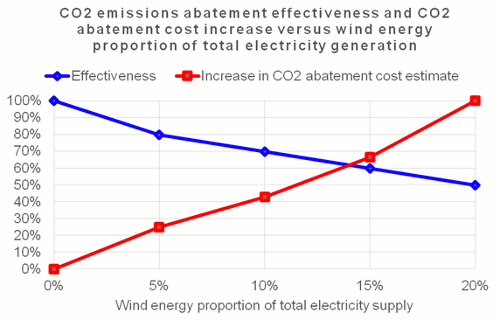Wind turbines are significantly less effective at reducing CO2 emissions than commonly assumed. This means the CO2 abatement cost (i.e. the cost per tonne CO2 avoided by wind turbines) is higher than commonly recognised. It is likely the CO2 abatement cost of wind turbines is commonly underestimated.
Effectiveness here means % reduction in CO2 emissions divided by % electricity supplied by wind turbines. Wind turbines supplied 2.9%of Australia's electricity in 2012-13 (latest figures available). It is likely wind energy was around 80% effective at avoiding CO2 emissions. That is, each unit of electricity generated by wind turbines avoided about 80% of the emission that would have been emitted generating a unit of electricity in the absence of wind.
The actual CO2 abatement cost is higher than commonly estimated. In fact, the abatement cost is inversely proportional to the proportion of electricity supplied by wind power. At 80% effective the actual abatement cost would be 25% higher than the analysts' estimates if their estimates did not take effectiveness into account. At 50% effective the actual abatement cost would be twice the estimates. The chart below illustrates the relationship between effectiveness, CO2 abatement costs increase and the proportion of electricity generated by wind (80% effective is approximately correct for Australia's National Electricity Market in 2014; effectiveness at proportions of wind energy above 5% are a rough estimate for the purpose of this explanation).
Advertisement

Economic analyses conducted for the 2014 Renewable Energy Target (RET) Review projected that wind power will supply about 15% of Australia's electricity by 2020 if the RET legislation remains unchanged. At 15% of electricity generated by wind, international studies of other electricity grids suggests effectiveness could be nearly as low as 50%. At that rate the CO2 abatement cost would be double the estimates (if those estimates did not take effectiveness into account).
The cost of abating CO2 emissions with wind power in Australia in 2020 could be 2 to 5 times the carbon tax, which was rejected by the voters at 2013 Federal Election; 6 to14 times the current EU carbon price; and more than 100 times the price of the international carbon futures out to 2020.
A Senate 'Select Committee on Wind Turbines' has been established to inquire into the impacts of wind turbines in Australia. My submission focuses on the effectiveness of wind turbines at reducing CO2 emissions from electricity generation in Australia and the impact of the effectiveness on estimates of abatement cost ($/tonne CO2) by wind energy.
My submission is No. 259 here.
Discuss in our Forums
See what other readers are saying about this article!
Click here to read & post comments.
21 posts so far.
About the Author
Peter Lang is a retired geologist and engineer with 40
years experience on a wide range of energy projects throughout the world,
including managing energy R&D and providing policy advice for government and
opposition. His experience includes: hydro, geothermal, nuclear, coal, oil, and
gas plants and a wide range of energy end use management projects.